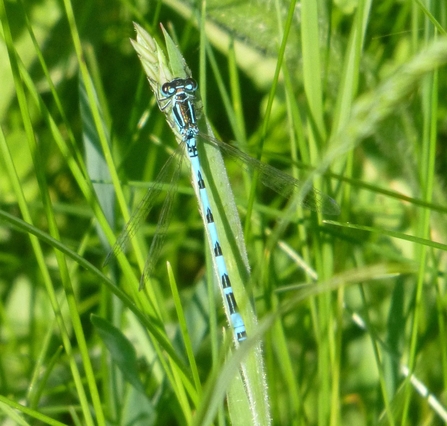The Letcombe Brook at Letcombe Valley. Photo by Stacey Doran
Where to go in August
Letcombe Valley, Oxon
The lovely mix of chalk stream, woodland and chalk grassland creates a tranquil haven for wildlife and people at this nature reserve.
The Letcombe Brook is a rare habitat - there are only two chalk streams in the whole of Oxfordshire and only 161 UK-wide. Running along the eastern edge of the reserve is a steep bank with a flat top (the Old Bassett Road) where fragments of chalk grassland remain among the scrub and are filled with wild flowers in summer.
There are some surfaced and some unsurfaced paths, steps and kissing gates at this site.
Come along to the Letcombe Valley Wildlife Discovery Day on Saturday 19 August, 2-4.30pm, to find out more about the reserve ad wildlife.

Southern damselfly. Picture: Anne Jackson
Parsonage Moor, Oxon
A fenland wilderness rich in botanical gems, moths and dragonflies. It's particularly rich in plants for its size with more than 300 different species recorded here including some intriguing insectivorous species such as butterwort.
This site is also excellent for birds and insects. Look out for the day-flying scarlet tiger moth, and dragonflies and damselflies, including the nationally-rare southern damselfly.
There are boardwalks above the wet ground and kissing gates. There are also ponies grazing the fen.
Park at nearby Dry Sandford Pit and walk over to explore Parsonage Moor. Why not explore the whole of the Cothill Fen area, including several other BBOWT nature reserves, on our circular wild walk.

Marbled White (Melanagria galathea) resting on Small Scabious (Scabiosa colombaria) by Guy Edwardes/2020VISION
Watts Bank, Berks
This small reserve on a steep southwest slope is part of a larger wildlife site named after the adjacent track from Lambourn, the White Shute Byway. Fragments of wildflower-rich chalk grassland, like Watts Bank, have usually survived because they are situated on a hill or earthworks which are unsuitable for ploughing.
This grassland hillside is a natural sun trap, sheltered from wind by patches of scrub at each corner. It is very attractive to butterflies, with an impressive 32 species recorded, including chalkhill blue, green hairstreak, brown argus and dingy skipper. They fly amongst the wild flowers and at least 16 species of grass including quaking-grass, whose purplish-green flowers dance delicately in the breeze.
There are no formal paths through the reserve, which has steep slopes and rough, sloping ground. There are stiles and gates.

Brown hairstreak by Philip Precey
Whitecross Green Wood, Bucks
A dynamic yet fragile woodland habitat renowned for its beautiful butterflies and wild flowers along the wide, grassy rides.
In summer butterflies are abundant. BBOWT's careful management of the blackthorn bushes is helping to strengthen the survival of rare black and brown hairstreaks.
Please stick to the mown rides when visiting the reserve to help protect the flowers growing along the woodland edges.
This reserves is mainly flat but sloping at the southern end. There are some bumpy paths and a rest bench.

WildNet - Margaret Holland
Wildmoor Heath, Berks
Wildmoor Heath is a precious survival of rare heathland habitat and through the year is home to a rich, but fragile, community of fungi, insects, reptiles, birds, mosses and flowering plants.
The reserve is a fantastic place to look for dragonflies and damselflies. More than 20 species have been recorded here. You can enjoy these beautiful insects from boardwalks that cross some parts of the bog.
It's also a good place to look for the grayling butterfly, which is particularly well-camouflaged when it's sunbathing on the ground.
The ground here is mainly firm and gently sloping with sandy paths but there is some boggy peat and areas of rough ground. There are gates, stiles and boardwalks over the wetter sections.
Adonis blue butterfly. Photo by Colin Williams
Yoesden, Bucks
Yoesden is a beautiful example of the traditional Chiltern landscape in south Buckinghamshire. A swathe of chalk grassland undamaged by ploughing, fertilisers and intensive grazing is packed with rare butterflies and wild flowers and is topped by a ‘hanger’ woodland of beech, yew and whitebeam trees on the edge of a steeply sided valley.
It is considered by many as one of the jewels of the Chilterns Area of Outstanding Natural Beauty for the numbers of butterflies found on site. 28 species have been recorded, including three scarce blue species: Adonis, chalkhill and small blue butterflies, all of which rely on the flower-rich grassland that makes up about half of the reserve.
Late in the summer the colours change to a much deeper purple with carpets of Devil’s-bit scabious, knapweed and Chiltern gentians starting to dominate areas of the grassland.
The ground is sloping, steep and stony in places. It can be muddy in places after rain. There are kissing gates and gates; and a rest bench.



